
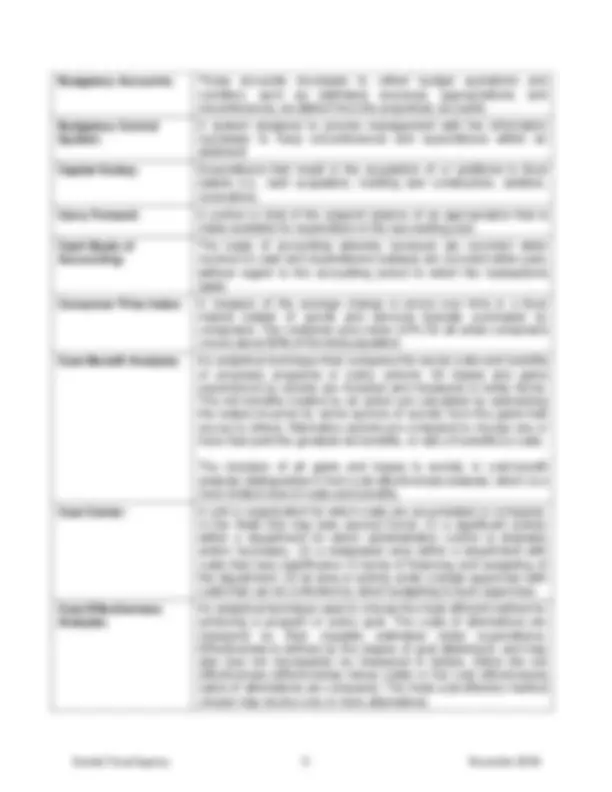
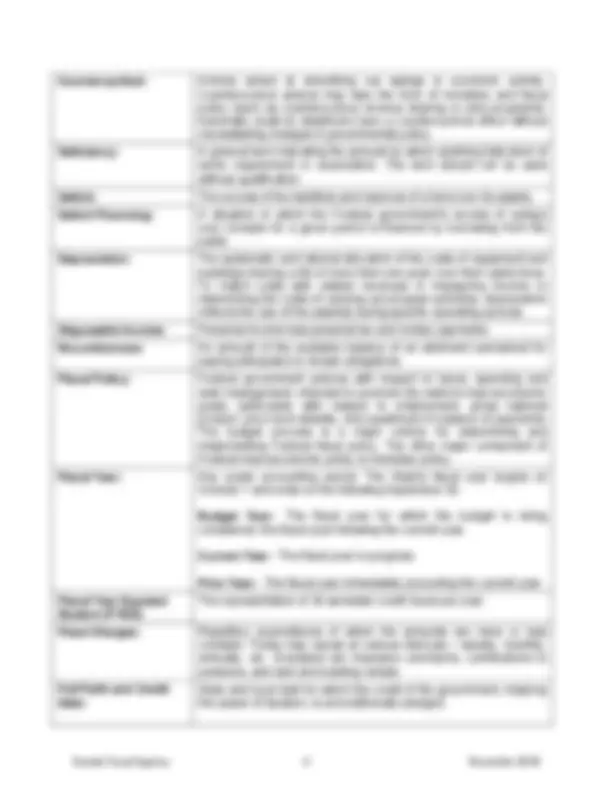
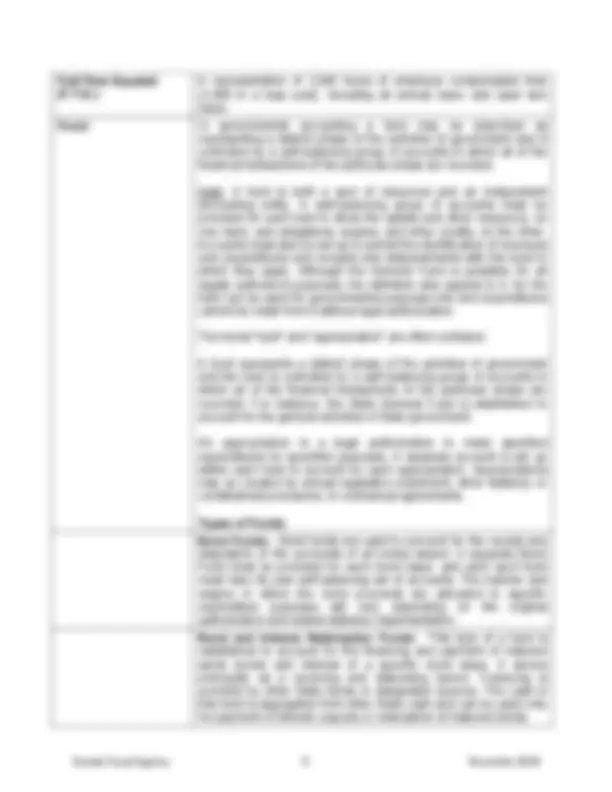
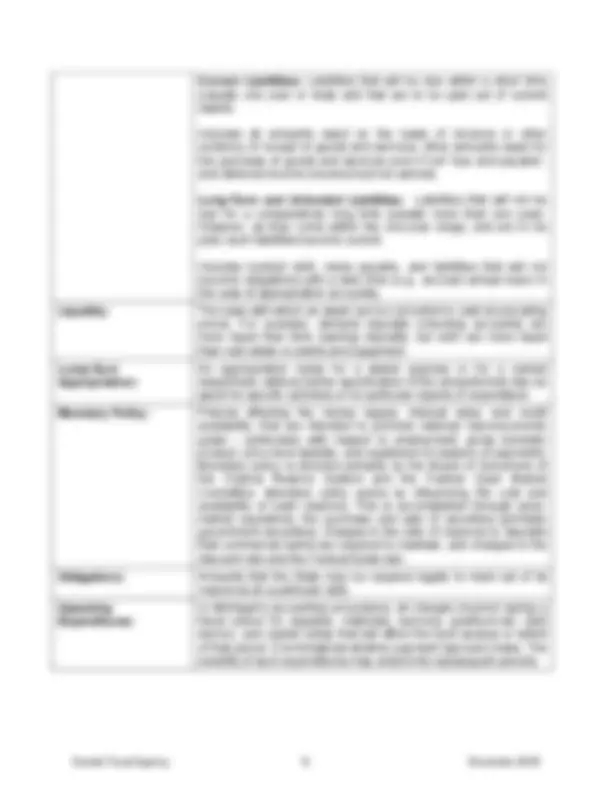
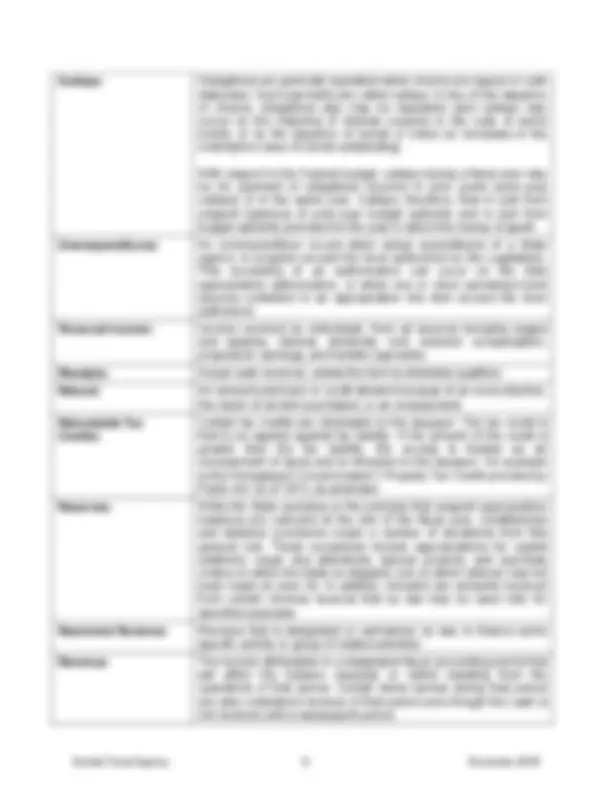
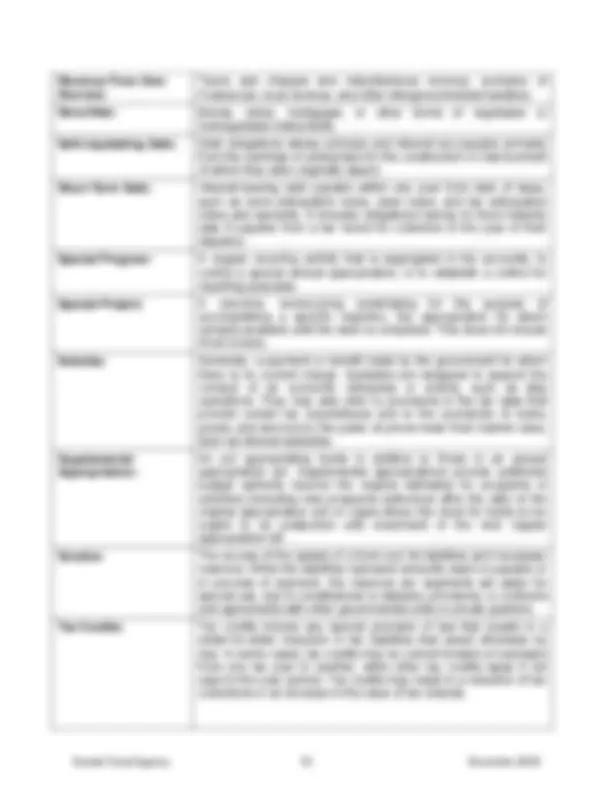


Study with the several resources on Docsity

Earn points by helping other students or get them with a premium plan


Prepare for your exams
Study with the several resources on Docsity

Earn points to download
Earn points by helping other students or get them with a premium plan
Community
Ask the community for help and clear up your study doubts
Discover the best universities in your country according to Docsity users
Free resources
Download our free guides on studying techniques, anxiety management strategies, and thesis advice from Docsity tutors
An overview of accounting principles and practices related to state finances. Topics include Accounts Receivable, Accrual Basis of Accounting, Gross Appropriations, State Spending from State Resources, Assets, Baseline Revenue, Budget, Budget Authority, Budgetary Accounts, Carry Forward, Cash Basis of Accounting, Consumer Price Index, Depreciation, and various types of funds such as Bond Funds, Restricted Funds, and Trust and Agency Funds. The document also covers Liabilities, Appropriations, Overexpenditures, Restricted Revenue, Revenue from Own Sources, Supplemental Appropriations, Tax Credits, and Tax Expenditures.
Typology: Study notes
1 / 11

This page cannot be seen from the preview
Don't miss anything!







Accounting Period: A period at the end of which and for which financial statements are prepared.
Accounting Procedure : A group of closely related clerical operations which comprise a subjunction of a system.
Accounting System: Records and procedures, both formal and informal, that relate to the assembling, recording and reporting of information related to the financial operations, and that also provide necessary internal controls.
Accounts Payable: Amounts owed to others for goods and services received and assets acquired.
Accounts Receivable: (^) Amounts due from others for goods furnished and services rendered. Such amounts include reimbursements earned and refunds receivable.
Accrual Basis of Accounting:
The basis of accounting under which revenues are recorded when earned and expenditures are recorded when goods are received and services performed even though the receipt of the revenue or the payment of the expenditure may take place, in whole or part, in another accounting period.
Activity: A specific line of work carried on by a governmental unit in order to perform its function as specified by constitutional, statutory, or administrative fiat.
Allotment: A portion of an appropriation set aside for use during a certain period or for a particular purpose.
Appropriation: (^) An authorization granted by the constitution or the legislature to make expenditures and to incur obligations for a specific purpose. An appropriation is usually limited in amount and as to the time when it may be spent, normally calendar or fiscal year. In the case of Michigan, the time is October 1 to September 30.
Gross Appropriations: Total level of State appropriations from all fund sources
Adjusted Gross Appropriations: Total Gross Appropriations excluding interdepartmental grants and transfers
State Spending from State Resources Appropriations: Total level of State appropriations excluding Federal, local, and private funding sources; includes only State Restricted and General Fund/ General Purpose appropriations
State Restricted Revenue Appropriations: State taxes or fees that are designated for a specific purpose in the budget by either constitutional or statutory requirements
General Fund/General Purpose Appropriations: Unrestricted portion of State budget fund sources
Assets: (^) Any item of economic value owned by a governmental unit. The item may be physical in nature (tangible) or a right to ownership (intangible) that is expressed in terms of cost or some other value.
Audit: The examination of some or all of the following items: documents, records, reports, systems of internal control, accounting procedures, and other evidence, for one or more of the following purposes: (a) determining the propriety, legality, and mathematical accuracy of proposed or consummated transactions; (b) ascertaining whether all transactions have been recorded; and (c) determining whether transactions are accurately reflected in the accounts and in the statements drawn therefrom in accordance with accepted accounting principles.
Note: The term "audit" is sometimes applied to the examination of a single transaction; for example, the audit of an invoice; that is, the checking of an invoice and supporting evidence for the purpose of approving the invoice for payment and properly reflecting the transaction in the accounts. This is referred to as preaudit. On the other hand, even a limited special audit involves the examination of documents, records, reports, systems of internal control, and other evidence. The term "audit" is, thus, of little significance when used without a modifier.
Balanced Budget: A budget in which receipts are equal to or greater than outlays.
Baseline Revenue: Total revenue excluding revenue derived from one-time revenue items and tax structure changes. One-time revenue items typically include such things as an accounting change that results in a one- time revenue gain during the period when the change is implemented or a one-time transfer of revenue from one fund to another fund. Tax structure changes include tax rate increases or decreases, and additions to or subtractions from the base of a tax.
Boilerplate: (^) Intent language in appropriation bills.
Budget: A plan of financial operation embodying an estimate of proposed expenditures for a given period or purpose and the proposed means of financing them.
Note: The term "budget" is used in two senses in practice. Sometimes it designates the financial plan presented to the legislature for adoption and sometimes the plan finally approved by that body. It is usually necessary to specify whether the budget under consideration is preliminary and tentative or whether it has been approved by the legislature. The term is also sometimes confused with the budget document.
Budget Authority: Authority provided by law to enter into obligations that will result in immediate or future outlays involving State government funds.
Countercyclical: Actions aimed at smoothing out swings in economic activity. Countercyclical actions may take the form of monetary and fiscal policy (such as countercyclical revenue sharing or jobs programs). Automatic (built-in) stabilizers have a countercyclical effect without necessitating changes in governmental policy.
Deficiency: A general term indicating the amount by which anything falls short of some requirement or expectation. The term should not be used without qualification.
Deficit: The excess of the liabilities and reserves of a fund over its assets.
Deficit Financing: A situation in which the Federal government's excess of outlays over receipts for a given period is financed by borrowing from the public.
Depreciation: The systematic and rational allocation of the costs of equipment and buildings (having a life of more than one year) over their useful lives. To match costs with related revenues in measuring income or determining the costs of carrying out program activities, depreciation reflects the use of the asset(s) during specific operating periods.
Disposable Income: Personal income less personal tax and nontax payments.
Encumbrances: An amount of the available balance of an allotment earmarked for paying anticipated or known obligations.
Fiscal Policy: Federal government policies with respect to taxes, spending and debt management, intended to promote the nation's macroeconomic goals, particularly with respect to employment, gross national product, price level stability, and equilibrium in balance of payments. The budget process is a major vehicle for determining and implementing Federal fiscal policy. The other major component of Federal macroeconomic policy is monetary policy.
Fiscal Year: Any yearly accounting period. The State's fiscal year begins on October 1 and ends on the following September 30.
Budget Year: The fiscal year for which the budget is being considered; the fiscal year following the current year.
Current Year: The fiscal year in progress.
Prior Year: The fiscal year immediately preceding the current year.
Fiscal Year Equated Student (FYES):
The representation of 30 semester credit hours per year.
Fixed Charges: Repetitive expenditures of which the amounts are more or less constant. These may repeat at various intervals – weekly, monthly, annually, etc. Examples are insurance premiums, contributions to pensions, and land and building rentals.
Full Faith and Credit Debt:
State and local debt for which the credit of the government, implying the power of taxation, is unconditionally pledged.
Full-Time Equated (F.T.E.):
A representation of 2,080 hours of employee compensated time (2,088 in a leap year), including all annual leave and used sick leave.
Fund: In governmental accounting a fund may be described as representing a distinct phase of the activities of government and is controlled by a self-balancing group of accounts in which all of the financial transactions of the particular phase are recorded.
Note: A fund is both a sum of resources and an independent accounting entity. A self-balancing group of accounts must be provided for each fund to show the assets and other resources, on one hand, and obligations, surplus, and other credits, on the other. Accounts must also be set up to permit the identification of revenues and expenditures and receipts and disbursements with the fund to which they apply. Although the General Fund is available for all legally authorized purposes, the definition also applies to it, for the fund can be used for governmental purposes only and expenditures cannot be made from it without legal authorization.
The terms "fund" and "appropriation" are often confused.
A fund represents a distinct phase of the activities of government and the fund is controlled by a self-balancing group of accounts in which all of the financial transactions of the particular phase are recorded. For instance, the State General Fund is established to account for the general activities of State government.
An appropriation is a legal authorization to make specified expenditures for specified purposes. A separate account is set up within each fund to account for each appropriation. Appropriations may be created by annual legislative enactment, other statutory or constitutional provisions, or contractual agreements.
Types of Funds: Bond Funds: Bond funds are used to account for the receipt and disposition of the proceeds of all bonds issued. A separate Bond Fund must be provided for each bond issue, and each such fund must have its own self-balancing set of accounts. The manner and degree in which the bond proceeds are allocated to specific expenditure purposes will vary depending on the original authorization and related statutory implementation. Bond and Interest Redemption Funds: This type of a fund is established to account for the financing and payment of matured serial bonds and interest of a specific bond issue. It serves principally as a receiving and disbursing device. Financing is provided by other State funds or designated sources. The cash in this fund is segregated from other State cash and can be used only for payment of interest coupons or redemption of matured bonds.
expenditures and it is necessary to set up accounts to show the kind of receipts and the nature of expenditures. At the end of a fiscal period, the receipts and expenditures are closed out and the difference is used to increase or decrease the fund balance. All receipts and expenditures of trust and agency funds are of a nonoperating nature.
Generally Accepted Accounting Principles:
Accounting procedures and methods established by the Governmental Accounting Standards Board (GASB).
Grant: In governmental terminology, a contribution to or from a unit of government for specific or general purposes. This may take the form of donations, bequests, payments to or for local units, aid, reimbursements, etc. According to the Constitution of the State of Michigan, grants must be passed by a 2/3 vote in the Senate and House.
Grants-In-Aid: Payments made by one government unit to another government unit for specified purposes. They represent Federal support for a State or locally administered program, or State support for a local program.
Gross Domestic Product:
The market value of the output of all goods and services produced by the nation's economy, before deduction of depreciation charges and other allowances for capital consumption.
Indirect Cost: Any cost that is incurred for common objectives and therefore cannot be directly charged to any single cost objective. These costs are allocated to the various classes of work in proportion to the benefit to each class. Indirect cost is also referred to as overhead or burden cost.
Inflation: A rise in the general price level that results in a decline in the purchasing power of money.
Labor Force: All persons 16 years of age or over who are either employed or unemployed and actively looking for a job. Total labor force includes members of the armed forces stationed either in the United States or abroad. They are excluded from civilian labor force.
Lapse: As applied to appropriations, the termination of all or part of the balance of an appropriation. An appropriation is usually made for the period of a fiscal year, at the end of which the balance is lapsed, subject to constitutional and/or statutory directives.
Liabilities: Amounts owed for items received, services rendered, expenses incurred, assets acquired, construction performed (regardless of whether invoices have been received), and amounts received but as yet unearned.
Included are amounts owed for goods in the hands of contractors under the constructive delivery concept (when the records of the agency provide such information), and amounts owed under grants, pensions, awards, and other indebtedness not involving the furnishing of goods and services. The two classifications occurring most frequently are the following:
Current Liabilities: Liabilities that will be due within a short time (usually one year or less) and that are to be paid out of current assets.
Includes all amounts owed on the basis of invoices or other evidence of receipt of goods and services, other amounts owed for the purchase of goods and services even if not "due and payable", and deferred income (received but not earned).
Long-Term and Unfunded Liabilities: Liabilities that will not be due for a comparatively long time (usually more than one year). However, as they come within the one-year range, and are to be paid, such liabilities become current.
Includes bonded debt, notes payable, and liabilities that will not become obligations until a later time (e.g., accrued annual leave in the case of appropriation accounts).
Liquidity: The ease with which an asset can be converted to cash at prevailing prices. For example, demand deposits (checking accounts) are more liquid than time (saving) deposits, but both are more liquid than real estate or plants and equipment.
Lump-Sum Appropriation:
An appropriation made for a stated purpose or for a named department, without further specification of the amounts that may be spent for specific activities or for particular objects of expenditure.
Monetary Policy: Policies affecting the money supply, interest rates, and credit availability, that are intended to promote national macroeconomic goals – particularly with respect to employment, gross domestic product, price level stability, and equilibrium in balance of payments. Monetary policy is directed primarily by the Board of Governors of the Federal Reserve System and the Federal Open Market Committee. Monetary policy works by influencing the cost and availability of bank reserves. This is accomplished through open- market operations, the purchase and sale of securities (primarily government securities), changes in the ratio of reserves to deposits that commercial banks are required to maintain, and changes in the discount rate and the Federal funds rate.
Obligations: Amounts that the State may be required legally to meet out of its resources at a particular date.
Operating Expenditures:
In Michigan's accounting procedures, all charges incurred during a fiscal period for supplies, materials, services, grants-in-aid, debt service, and capital outlay that will affect the fund surplus or deficit of that period. It is immaterial whether payment has been made. The benefits of such expenditures may extend into subsequent periods.
Revenue From Own Sources:
Taxes and charges and miscellaneous revenue, exclusive of Federal aid, local revenue, and other intergovernmental transfers.
Securities: (^) Bonds, notes, mortgages, or other forms of negotiable or nonnegotiable instruments.
Self-Liquidating Debt: Debt obligations whose principle and interest are payable primarily from the earnings of enterprises for the construction or improvement of which they were originally issued.
Short-Term Debt: Interest-bearing debt payable within one year from date of issue, such as bond anticipation notes, bank loans, and tax anticipation notes and warrants. It includes obligations having no fixed maturity date if payable from a tax levied for collection in the year of their issuance.
Special Program: A regular recurring activity that is segregated in the accounts, to control a special annual appropriation, or to establish a control for reporting purposes.
Special Project: A one-time, nonrecurring undertaking for the purpose of accomplishing a specific objective, the appropriation for which remains available until the work is completed. This does not include Work Orders.
Subsidy: Generally, a payment or benefit made by the government for which there is no current charge. Subsidies are designed to support the conduct of an economic enterprise or activity, such as ship operations. They may also refer to provisions in the tax laws that provide certain tax expenditures and to the provisions of loans, goods, and services to the public at prices lower than market value, such as interest subsidies.
Supplemental Appropriation:
An act appropriating funds in addition to those in an annual appropriation act. Supplemental appropriations provide additional budget authority beyond the original estimates for programs or activities (including new programs authorized after the date of the original appropriation act) in cases where the need for funds is too urgent to be postponed until enactment of the next regular appropriation bill.
Surplus: The excess of the assets of a fund over its liabilities and necessary reserves. While the liabilities represent amounts owed or payable or in process of payment, the reserves are segments set aside for special use, due to constitutional or statutory provisions, or contracts and agreements with other governmental units or private grantors.
Tax Credits: Tax credits include any special provision of law that results in a dollar-for-dollar reduction in tax liabilities that would otherwise be due. In some cases, tax credits may be carried forward or backward from one tax year to another, while other tax credits lapse if not used in the year earned. Tax credits may result in a reduction of tax collections or an increase in the value of tax refunds.
Tax Expenditures: Revenue losses attributable to provisions of the tax laws that allow special exclusions or deductions or that provide a special credit, preferential tax rate, or deferral of tax liability.
Taxes: Sums imposed by a government authority upon persons or property to pay for government services. The power to impose and collect taxes is given to the legislature in Article 9, Section 1 of the State Constitution of 1963.
Total Debt: All long-term obligations of the government and its agencies (whether backed by the unit of government's full faith and credit or nonguaranteed) and all interest-bearing short-term credit obligations. Long-term obligations are those repayable more than one year after issue.
Transfer Between Appropriation/Fund Accounts:
A transaction that, pursuant to law, withdraws budget authority or balances from one appropriation account for credit to another.
Transfer Payments: Payments to individuals by government and business for which no goods or services are currently rendered. Examples are benefits from social insurance funds, relief payments, military pensions, and corporate gifts to nonprofit institutions.
Unalloted Balance of Appropriation:
An appropriation balance available for allotment.
Unencumbered Balance of Allotment:
That portion of an allotment not yet spent or encumbered; the balance remaining after deducting from the allotment the accumulated expenditures and outstanding encumbrances.
Work in Process: The cost of partially completed products that are being manufactured. Sometimes referred to as "Work in Progress".
Work Order Account: (^) An account established by, or from, an appropriation for a project for the construction, alteration, addition, or major repair, of a building or structure, including site.
Work Project: A one-time nonrecurring undertaking for the purpose of accomplishing an objective contained in a specific line-item appropriation, or any other specific line-item appropriation designated as a work project pursuant to the Management and Budget Act, Sec. 451a.
Zero Base Budgeting: A process emphasizing management's responsibility to plan, budget, and evaluate. Zero-base budgeting provides for analysis of alternative methods of operation and various levels of effort. It places new programs on an equal footing with existing programs by requiring that program priorities be ranked, thereby providing a systematic basis for allocating resources.